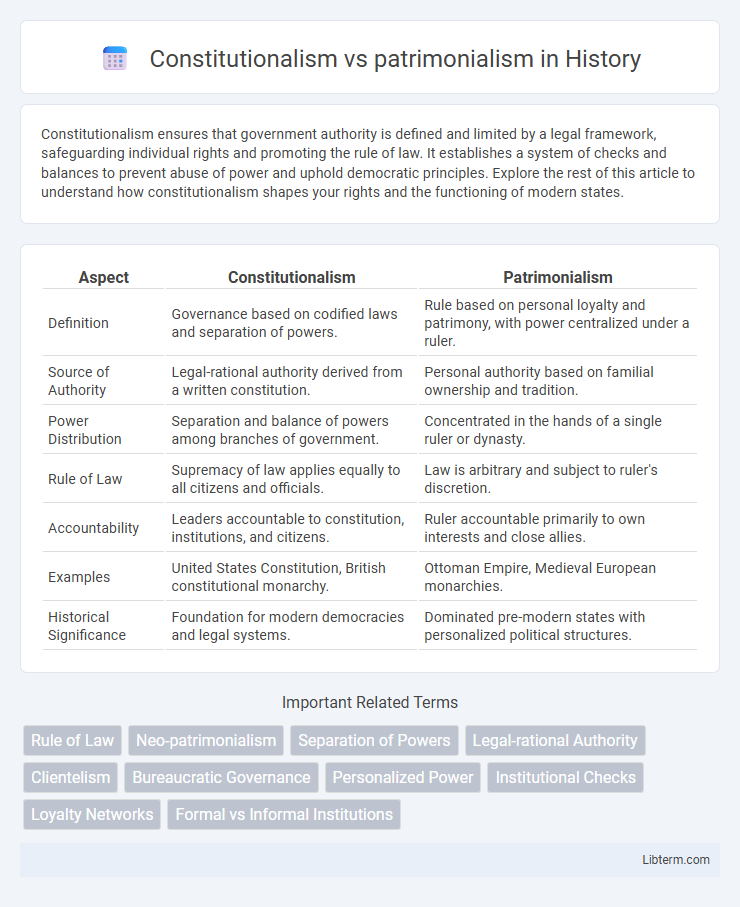Constitutionalism ensures that government authority is defined and limited by a legal framework, safeguarding individual rights and promoting the rule of law. It establishes a system of checks and balances to prevent abuse of power and uphold democratic principles. Explore the rest of this article to understand how constitutionalism shapes your rights and the functioning of modern states.
Table of Comparison
| Aspect | Constitutionalism | Patrimonialism |
|---|---|---|
| Definition | Governance based on codified laws and separation of powers. | Rule based on personal loyalty and patrimony, with power centralized under a ruler. |
| Source of Authority | Legal-rational authority derived from a written constitution. | Personal authority based on familial ownership and tradition. |
| Power Distribution | Separation and balance of powers among branches of government. | Concentrated in the hands of a single ruler or dynasty. |
| Rule of Law | Supremacy of law applies equally to all citizens and officials. | Law is arbitrary and subject to ruler's discretion. |
| Accountability | Leaders accountable to constitution, institutions, and citizens. | Ruler accountable primarily to own interests and close allies. |
| Examples | United States Constitution, British constitutional monarchy. | Ottoman Empire, Medieval European monarchies. |
| Historical Significance | Foundation for modern democracies and legal systems. | Dominated pre-modern states with personalized political structures. |
Defining Constitutionalism: Principles and Foundations
Constitutionalism is defined by the establishment of a legal framework that limits government powers and guarantees individual rights through codified laws and democratic institutions. It rests on principles such as the rule of law, separation of powers, accountability, and protection of fundamental freedoms. This framework contrasts sharply with patrimonialism, where authority is concentrated in a single ruler or elite group, governance is personalized, and legal-rational norms are weak or subverted.
Understanding Patrimonialism: Key Characteristics
Patrimonialism is a form of governance where all power flows directly from the leader, blending public and private authority, often resulting in a lack of institutional constraints. In this system, administrative positions are treated as personal assets, leading to the use of state resources for personal gain and favoritism towards close allies and family. Unlike constitutionalism, patrimonialism lacks formal rule of law, accountability mechanisms, and clear separation between state and personal interests.
Historical Evolution of Constitutionalism
Constitutionalism historically evolved as a framework limiting state power through codified principles, beginning with the Magna Carta in 1215, which established legal constraints on the monarchy. The Enlightenment further propelled constitutional ideas by emphasizing individual rights and separation of powers, culminating in landmark documents like the U.S. Constitution (1787) and the French Declaration of the Rights of Man (1789). This evolution contrasts with patrimonialism, where governance is based on personal loyalty and centralized authority without formal legal constraints.
Origins and Development of Patrimonial Systems
Patrimonialism originates from pre-modern governance structures where authority is based on personal loyalty and familial ties rather than institutionalized law, often rooted in tribal or feudal systems. This system developed through the fusion of administrative and private authority, with rulers treating their office as personal property, leading to the centralization of power within a ruling family. Over time, patrimonialism persisted in various forms, particularly in regions where state formation was weak, contrasting sharply with constitutionalism's emphasis on codified laws and separation of powers.
Rule of Law vs. Personal Rule: Core Distinctions
Constitutionalism ensures governance based on established legal frameworks and the rule of law, where laws apply equally to all individuals and government actions are legally constrained. In contrast, patrimonialism centers on personal rule, where authority is exercised through patronage and the ruler's discretion, often bypassing formal legal structures. The core distinction lies in constitutionalism promoting institutional accountability, whereas patrimonialism relies on personalized power networks and arbitrary decision-making.
Political Accountability in Constitutionalism and Patrimonialism
Political accountability in constitutionalism is ensured through established legal frameworks, separation of powers, and regular elections that hold public officials responsible to the law and citizens. In contrast, patrimonialism lacks formal mechanisms for accountability, with authority concentrated in the hands of a ruler who governs personalistically and often arbitrarily. This limits transparency and citizen oversight, fostering governance based on loyalty and patronage rather than rule of law.
Impact on Governance and Public Institutions
Constitutionalism promotes the rule of law, accountability, and separation of powers, ensuring transparent governance and strengthening public institutions through checks and balances. Patrimonialism concentrates power in the hands of a single ruler or elite, undermining institutional autonomy and fostering corruption, often leading to weak governance structures. Consequently, constitutional regimes tend to develop more resilient, efficient public institutions compared to patrimonial systems where governance is personalized and unstable.
Economic Implications of Both Systems
Constitutionalism promotes economic stability by enforcing rule of law, protecting property rights, and ensuring transparent governance, which attracts investment and fosters sustainable growth. In contrast, patrimonialism often leads to economic inefficiencies due to nepotism, lack of legal protections, and resource misallocation, undermining market confidence and hindering development. The predictability and accountability embedded in constitutional systems create favorable conditions for entrepreneurship and capital accumulation, while patrimonial regimes tend to perpetuate corruption and economic stagnation.
Contemporary Examples: Case Studies and Comparisons
Constitutionalism is exemplified by countries like the United States and Germany, where institutional checks and balances and rule of law constrain executive power and protect individual rights. In contrast, patrimonialism persists in states such as Saudi Arabia and Zimbabwe, where political authority is personalized, centralized around loyalty networks, and state resources are treated as private assets. Comparative case studies highlight how constitutional systems promote accountability and stability, whereas patrimonial regimes often face challenges of corruption and weak governance.
Challenges and Prospects for Reform
Constitutionalism faces challenges such as entrenched patronage networks and weak institutional checks that hinder effective governance reforms. Patrimonialism often resists change by prioritizing personal loyalty over rule of law, complicating efforts to establish transparent legal frameworks. Prospects for reform depend on strengthening institutional accountability and fostering civic engagement to shift power from informal to formal political structures.
Constitutionalism Infographic

 libterm.com
libterm.com